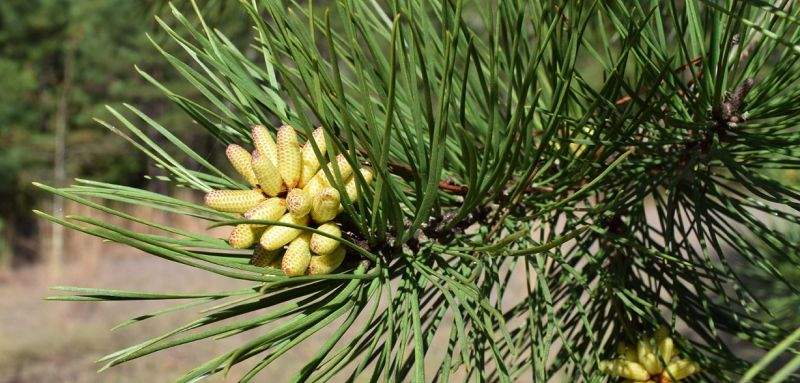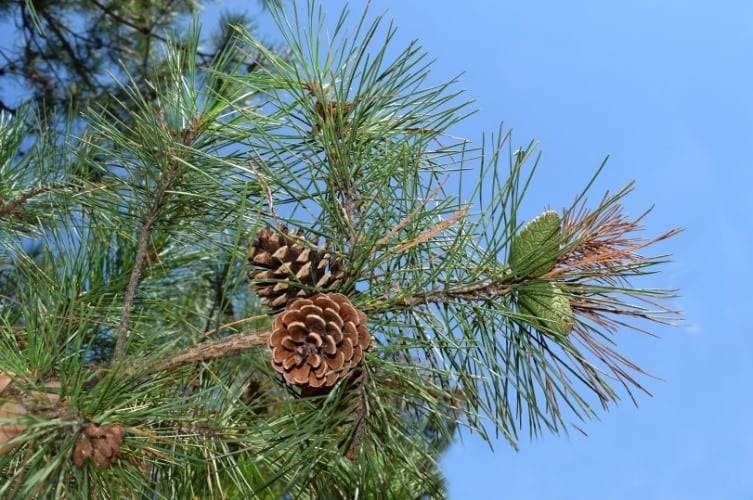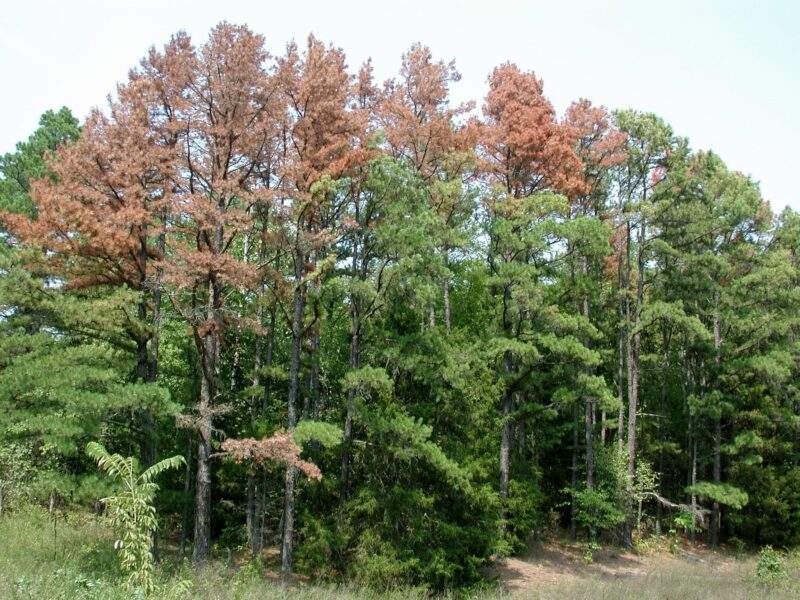20 Interesting Facts about the Shortleaf Pine Tree

Pine trees are evergreen trees that are used for many purposes. A pine tree grows to around 100 feet and has a conical shape with branches at the top and pointy ends. Its leaves are needle-like, and they are shed in the winter. The tree is often found in forests or near rivers, ponds, lakes, or other bodies of water.
Various types of pine trees vary in height and how their needles grow. The needles are different depending on the type of pine tree. Shortleaf pine (Pinus echinata) is one of the most prominent and widely used. Here are some interesting Shortleaf pine tree facts that are worth knowing.
- It is an evergreen tree
- A shortleaf pine tree can live up to 400 years
- This tree has short needles, 2-5 inches, which occur in groups of 2 or 3
- A shortleaf pine tree can attain a maturity height of up to 120 feet
- Both male and female shortleaf pines produce cones
- Shortleaf pine trees release a scent when disturbed or overheated
- The word pine is derived from the Latin word pinus
- Its nuts contain vitamins B, K, and L
- The surface of a shortleaf pine tree is coated with cutin
- Shortleaf pine trees are used for Christmas trees
- The pine tree is a symbol of wisdom and longevity for native Americans
- Their crowns can be as wide as 20 feet
- Its needle size can range between 1-11 inches
- Its bark has resin pockets, which form small depressions
- Shortleaf pine seedlings form a J-shaped crook near the ground surface
- Some mature shortleaf trees are as short as 4 feet
- It is also known as the yellow pine
- The shortleaf pine tree attracts butterflies
- The shortleaf pine tree was first described in 1768 by Phillip Miller
- Its seed cones mature 2 years after pollination
Here are some of the frequently asked questions about shortleaf pine tree facts.

What are the characteristics of shortleaf pine trees?
Shortleaf pine trees are unique, and several characteristics make them different from other types of pine trees. They have a conical shape, and their branches are arranged at the top of the tree. They have a clear trunk that is lighter in color.
The branches are short, and the needles grow in groups of three. An open crown is formed when the tree reaches maturity. The needles are wide, have a round appearance and are very light in color. They are soft to the touch and have a silvery color, which makes them distinctive. The shortleaf pine trees also have the most flexible branches and can bend instead of snapping when left under a lot of weight or pressure.
They have one growth ring annually, each ring being from 1 to 2 inches wide. The bark is thin with a smooth surface that typically cracks. Some tiny knots also appear as lines on the tree’s trunk below its branches. The wood from shortleaf pine trees is lightweight and hard at the same time.
The leaves of the shortleaf pine are green and measure 1.5 to 2.5 inches long. The shiny, dark green color makes them look very attractive. Some leaves have red stripes that run from the base to the tip of the leaf, while others have yellow stripes, and others are solidly red or green.
The leaves are arranged in pairs at regular intervals along the stem, but those located at the tip of a branch usually grow alone on their own stems. The short leaf pine needles grow in clusters, meaning multiple needles grow on a single stem instead of on their branches. They are mostly clustered on two sides of the branch and are found in pairs, except for those located at the branch’s top.
The needles are long and slender and measure roughly 0.35 to 1.3 inches in length. They are less than 0.1 inches in width, with the largest ones being only 0.07 inches wide. They can grow as long as 4 inches but most often grow between 2 to 3 inches in length and about 1 inch in width. Despite their size, it is crucial to know that shortleaf pine trees have firm roots, which is essential because it keeps them upright despite the fact that more weight will be hanging from their branches due to the tree’s growth.
The species is natural to the United States but can also be found in Canada. The trees produce a lot of resin used to make turpentine and other products. They can survive in semi-desert areas or rocky terrain where other plants don’t grow well. They require low moisture conditions, but they should never be exposed to drought if at all possible. During a forest fire, these trees are resistant and help prevent fires from spreading further.
The shortleaf pine tends to grow after deciduous trees have died out, making them more likely to survive dry conditions. The trees are popular among foresters because they can be planted under the shade of more giant trees and grow well. They have a shallow root system that helps them to remain stable when exposed to strong winds.
The branches are flexible, and it is not uncommon for them to bend instead of snapping when a lot of weight is placed on them. These trees have a lifespan of 150 years, but their growth rate depends on the conditions where they are planted. They tend to live longer in moist areas with fertile soil than in sandy areas.
The cones of the shortleaf pine are one of the most recognizable features of these trees; they can be up to 8 inches long. The cones are shaped in such a way that they hang on their branches when they develop. Once the cones reach maturity, they fall, and the seeds (pine nuts) are dispersed by wind or animals.
Pine nuts grow around 1 to 2 inches long and have a brown or greyish color that is sometimes covered with white fuzz. They have a flat appearance when mature but feel spongy when touched. A seed inside each nut is light green in color and has a hard surface that helps it stick securely on trees.
The bark of the shortleaf pines is smooth, and it is sometimes cracked. The color varies from greyish to brown or tan. The branches are flexible and bend instead of breaking, which makes them strong enough for various uses such as furniture production.

What is the leaf structure and composition of shortleaf pine trees?
The leaves that make up a shortleaf pine are quite different when compared to other plants. The leaves are light green in color and have a firm, stiff texture. They are also very brittle because they don’t have a lot of water content. The leaf tips come to a sharp or pointy point, which is actually due to the veining on them.
The veins are pressed up against each other. The color on the leaves is due to anthocyanin pigments, which effectively capture light that would otherwise be reflected into the atmosphere. The leaves also have an air-respiratory function and help to transfer carbon dioxide to cells for use in photosynthesis. They do this by having a large surface area, allowing more molecules to be obtained.
Shortleaf pines can grow in either full sun or partial shade. The essential oil, terpenes, phellogens, and tannins of the shortleaf pine trees are in much higher amounts in their leaves than in other plants. Some resin-producing trees have a high seed production rate, which is why they are called resin-producing plants. The seeds contain no carbohydrates whatsoever but instead, contain proteins that help them retain water during germination.
What are the uses of shortleaf pine trees?
The shortleaf pine tree has a wide range of uses. Its wood is the most durable and can be used to make furniture, paddles, wagons, and even furniture. It is also used to manufacture crates and boxes because of its strength. Furniture made of shortleaf pine is lighter than other types of pine trees.
The wood also makes good firewood because it burns slowly and cleanly. Numerous products can be made using the timber produced by shortleaf pine trees. The branches are used for making baskets and craft items like holiday decorations.
Timber from these trees is also used to make fence posts and railroad ties. Shortleaf pine trees are also used for making lumber, flooring, and pulp for paper. The tree is commonly used for windbreaks and as a guard against snow or ice. Most of the uses mentioned above require shortleaf pine timber to be very strong and durable.

How are shortleaf pine trees propagated?
Shortleaf pines are easy to grow from seed as long as you have a suitable location for them. The soil should be well drained and rich in organic matter. It should also be moist but never exposed to drought conditions. Space the seeds at least 6 feet apart so individual trees can grow without competing for sunlight and water sources.
When they sprout, remove the small amount of soil and the roots, so they don’t compete with each other. The seeds should be watered regularly and kept warm because cold temperatures can cause them to germinate poorly. The tiny seedlings that are developed after about a month will have sap running from their leaves, which will help them to survive when it gets too cold for them to survive.
Take care that the pines are not exposed to excessive heat during their growing cycle; otherwise, you may compromise their growth. The trees can be transplanted when they are about 6 to 8 inches tall. It is best to wait until spring before transplanting them, but if you have no choice and you need to transplant them during the colder months, make sure that you provide them with direct sunlight for about 4 hours each day for the first few weeks so that they get acclimated to the sun.
Shortleaf pine trees are very easy to propagate using techniques like grafting. Grafting is done by cutting a branch from a healthy tree and placing it on the trunk of another tree that has a branch available. If you’re looking for an alternate method of propagation, it is worth noting that they can be grown from seed as well.
How are shortleaf pine trees pruned?
The main purpose of pruning a shortleaf pine is to make it look aesthetically pleasing. The branches are flexible and can be bent in different directions, which makes them an excellent option for creating unique designs.
They can be pruned in any way you want as long as you do not harm their health or kill the entire tree. They can be used to create large, medium-sized, and backyard trees. If you plan on creating a large tree, then you should prune just the outer branches of the tree. However, removing too many branches at once can kill the tree and reduce the rate at which it grows.
Pruning the branches of a shortleaf pine tree is pretty simple; all you have to do is clean them up, so they look aesthetically pleasing. You can prune them in any way you want as long as you ensure that the branches are strong enough to support themselves and others. Pruning is usually done during spring or early summer when no leaves are on the trees.
The bole of a pine tree is very significant because it is the central part of the tree that produces all types of other parts of the tree, including leaves and fruit. The portions which contain sapwood and heartwood are known as the annual rings.
The portions that are between these two are known as semi-annual rings. The portions in between these three are known as multi-year rings. The growth ring of shortleaf pine is found at about ¼” in diameter (.635 cm) above a radial zone of lenticels that are about .03 inches (0.76 cm) apart.
Each year it grows, its sapwood produces new wood tissue, which is replaced by sapwood annually with each ring. The sapwood is lighter in color than the heartwood. Shortleaf pines are deciduous trees that lose their leaves and resin-producing buds annually. The leaves of their new growth fall off the old branches and form the new leaves for each year.
What is the nutrition content of shortleaf pine?
The nutritional content of shortleaf pines is quite similar to other trees like maple, oak, apple and alder. They contain phosphorus, potassium, calcium, and other minerals that help in all bodily functions. However, they have a low amount of Vitamin C and also low levels of Vitamin A and Vitamin E as compared to other trees like poplar, aspen or willow.
The plant absorbs water from the atmosphere, which is held in their leaves, and then transported to the roots for growth. The leaves are usually green in summer and turn a lighter color in the autumn to help with heat absorption.
The woody portions of the plant contain high amounts of tannins which can give off a bitter taste when eaten by animals such as bears and deer. However, due to their low levels of lignin, shortleaf pines are not very palatable to animals’ digestive systems.






